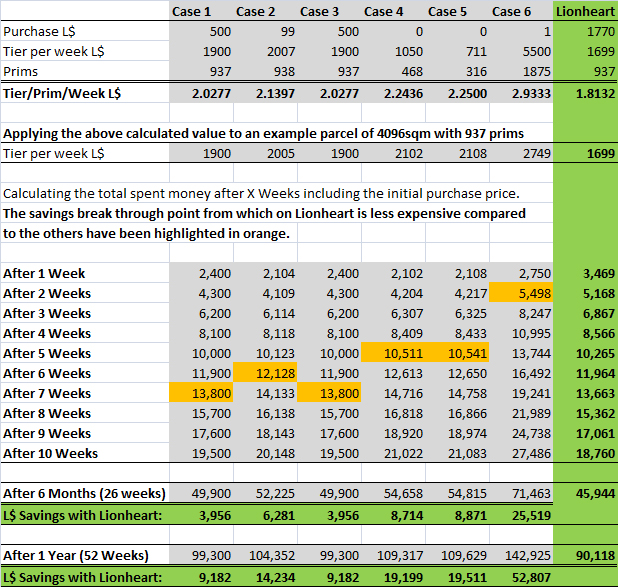These days, lots of estate companies advertise with “cheap” land, mostly selling off for a low purchase price like for example 1L$ or similar low values (50L$, 99L$ etc.), or even setting the land for sale at a price set for the exact value of your first week of tier.
At first glance, this seems to be to most people a real bargain, impossible to resist, and they often end up buying land at such estates. But when you look closer, you will see that cheap land is not always as cheap as it appears to be, but instead a well masked pricing model where the customer gets caught using the human instinct to make a quick bargain.
So why is this cheap land not a bargain?
Well, to say it easy: Every estate has the same costs to cover, except a few who enjoy grandfathered prices, which are anyway slowly discontinued by Linden Lab. This means, there is no real possibility for one estate to be cheaper than the other based on purchase prices (which are the subject of this article). Linden Lab wants to receive their fees every month in time, if a sim is fully occupied or not. If the estate owner cannot pay Linden Lab’s fees, the sim will close down.
This means for an estate, in order to be profitable, they have two ways to cover costs for unoccupied land as well as to somehow get their investment of purchasing the sim back (a fresh sim incl. 1 month tier costs between $600 and $1,000 of purchase): They can either ask their customers for an adequate purchase price, or they ask for higher tier fees. The latter is, what economically operating 1L$ estate companies do.
As a consequence, those who thought to have found a bargain piece of land, end up paying higher tier fees week after week. The initial saving quickly turns into higher costs for this land on long term.
Price Comparision with six “Cheap Land” Competitors
 We have gathered some price information from six competitors offering 1L$ or other similar low purchase priced land, or land set for sale for the value of the first week’s tier, and have compared these prices with those of Lionheart.
We have gathered some price information from six competitors offering 1L$ or other similar low purchase priced land, or land set for sale for the value of the first week’s tier, and have compared these prices with those of Lionheart.
The base value for comparing tier prices is how much L$ you pay per prim and week. Due to the fact that Lionheart uses US$ for tier pricing instead of L$, we have applied the L$ counter-value based on the exchange rate of currently 1.00USD/258L$.
As calculation example parcel size we’ve converted the values, based on the examples found, to a 4096sqm parcel with 937 prims.
Explanations to the table above
- Competitor No. 4 and 5 have set the purchase to the exact value of the first month’s / week’s tier. Thus, the purchase price equals zero (0.00L$).
- Lionheart includes the first week’s tier fees into the total purchase price. For comparision purposes, the real purchase value has been calculated by subtracting the included tier value.
Conclusion
As you can see, the first impression of a bargain can cost you often more money in the long run. It is always a good advice, to compare and calculate costs in the long term perspective. As mentioned before, an estate owner has to cover the costs of the estate. And in many occasions, they hide the costs in their tier fees, even if it would be more convenient for the customer to pay a little bit more upfront, but save in the long run.
Lionheart’s Bonus Programs
On top of the long term savings, Lionheart even offers further incentives for customers to stay long term and save even more money the longer you stay! Please click here to learn more about Lionheart’s Bonus Programs.
More Information about Land Pricing in Second Life
If you wish to read more into the topic of Land Pricing in Second Life, please read also our article “About Responsible Land Pricing in Second Life“.


